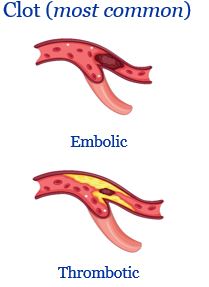|
Stroke is the fifth leading cause of death in the United States. More than 795,000 people have a stroke each year in the U.S. Every 3 minutes 14 seconds, someone dies of stroke. A stroke happens when something goes wrong with the blood flow in the brain. This can be because a blood vessel gets blocked or bursts, which can harm the brain.
|
|
Ischemic StrokeAn ischemic stroke happens when a blood clot blocks an artery in the brain. This damages the brain because it does not get enough blood and oxygen.
|
 |
Hemorrhagic StrokeA hemorrhagic stroke happens when a blood vessel in the brain bursts and bleeds. This harms the brain because too much blood leaks into the brain.
|
|
Transient Ischemic AttackA transient ischemic attack (TIA) happens when there is a temporary blockage in the blood flow to the brain.
|
|

